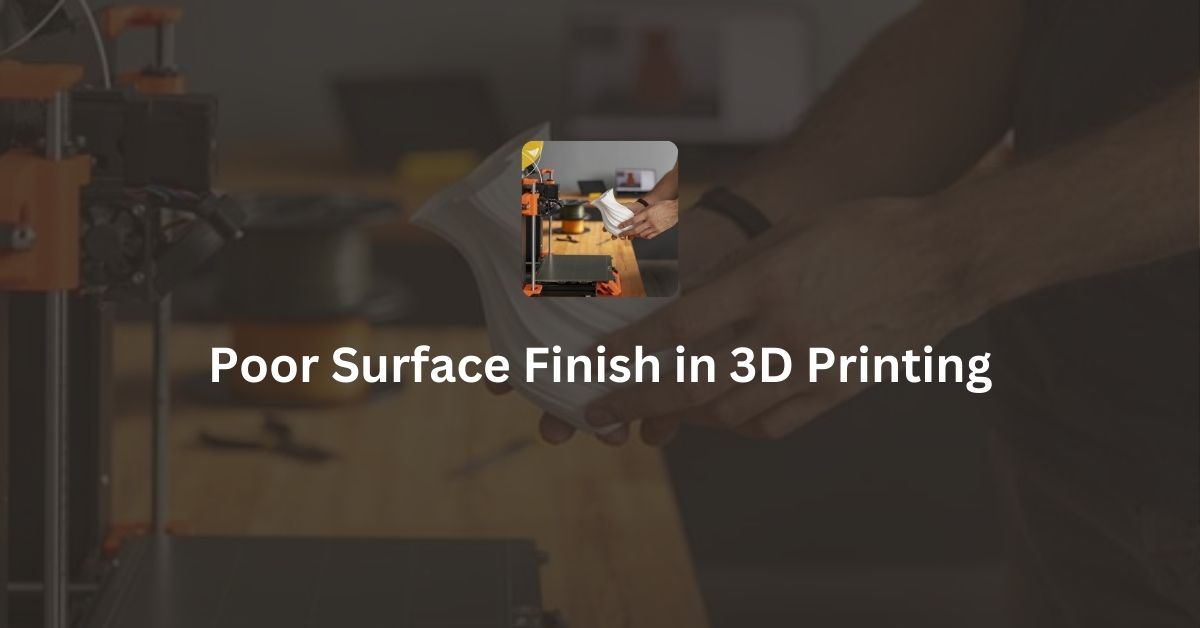While FDM 3D printing is great for many applications, one common problem that many users face is poor surface finish.
3D printing is an amazing technology that allows us to create objects layer by layer from digital designs. Fused Deposition Modeling (FDM) is one of the most widely used types of 3D printing. FDM printers work by melting a plastic filament and laying it down in thin layers to build an object.
In this blog post, I will discuss what causes poor surface finish in FDM 3D printing and how you can improve it. I have also written an extensive article covering all common defects in fdm 3d printing, you can read it here –> Commom Defects in FDM 3D Printing
What is Surface Finish?
Surface finish describes the texture and smoothness of a 3D-printed object’s outer layer. A good surface finish means that the object feels smooth to the touch and looks nice without visible lines or rough spots.
A poor surface finish, on the other hand, can have visible layer lines, rough patches, or other imperfections that make the object look and feel less polished.
Common Causes of Poor Surface Finish
- Layer Height: The layer height is the thickness of each layer of plastic that the printer lays down. A higher layer height can lead to a rougher surface because the layers are thicker and more visible. Reducing the layer height can result in a smoother surface finish, but it will also increase the print time.
- Print Speed: Printing too fast can cause the extruder to lay down the filament unevenly, leading to a rough surface. Slowing down the print speed can help improve the surface finish, as the printer has more time to carefully place each layer.
- Temperature Settings: The temperature of the printer’s nozzle and build plate can greatly affect the surface finish. If the nozzle temperature is too high or too low, the filament may not flow smoothly, causing bumps or rough patches on the print. Finding the right temperature settings for the filament you are using is crucial for achieving a good surface finish.
- Nozzle Size: The size of the printer’s nozzle can also impact the surface finish. A larger nozzle size can produce thicker layers, which may result in a rougher surface. Using a smaller nozzle can help create finer layers and a smoother finish, but it may take longer to print.
- Filament Quality: The quality of the filament you use can have a significant effect on the surface finish. Low-quality filaments may contain impurities or have inconsistent thickness, leading to uneven layers and poor surface quality. Choosing a high-quality filament can help reduce these issues.
- Printer Calibration: A poorly calibrated printer can cause various issues that affect surface finish. If the printer’s bed is not level or the hotend is not properly aligned, it can result in uneven layers and a rough surface. Regularly calibrating your printer can help ensure better print quality.
- Cooling Settings: Cooling is important for ensuring that each layer of plastic solidifies properly before the next one is laid down. If the cooling fan is not working correctly or the cooling settings are not properly adjusted, it can lead to warping, stringing, or other surface imperfections.
How to Improve Surface Finish?
- Adjust Layer Height: Use a smaller layer height for a smoother surface finish. While this may increase print time, the result will be a finer and more detailed print.
- Optimize Print Speed: Reduce the print speed to allow the printer more time to place each layer accurately. This can help achieve a more uniform surface finish.
- Calibrate Your Printer: Regularly check and calibrate your printer’s bed level and nozzle alignment. Accurate calibration helps ensure that layers are deposited evenly, which improves the overall quality of the print.
- Experiment with Temperature Settings: Find the optimal nozzle and bed temperature for the filament you are using. Start with the manufacturer’s recommended settings and adjust as needed to find the best temperature for a smooth surface finish.
- Use High-Quality Filament: Invest in high-quality filament with consistent thickness and fewer impurities. This will help produce smoother prints with fewer defects.
- Use a Smaller Nozzle: Consider using a nozzle with a smaller diameter for prints that require a very smooth finish. Smaller nozzles create finer layers, reducing the appearance of layer lines.
- Adjust Cooling Settings: Ensure that the cooling fan is working properly and adjust cooling settings to improve layer adhesion and reduce surface imperfections.
Conclusion
Poor surface finish in FDM 3D printing can be caused by a variety of factors, including layer height, print speed, temperature settings, and filament quality.
By learning about these factors and making the right adjustments, you can greatly enhance the surface quality of your 3D prints. Achieving the perfect surface finish may require some trial and error, but with patience and practice, you can create smooth, high-quality prints every time.
Happy printing!
Defects in FDM 3D Printing
